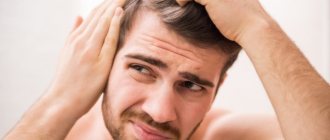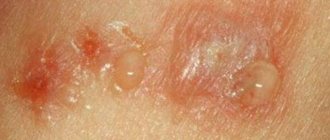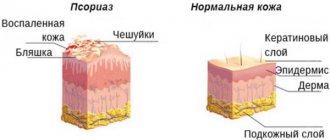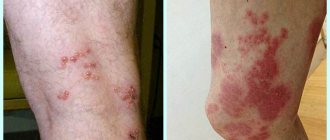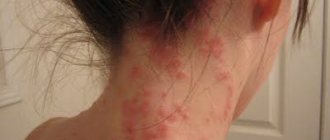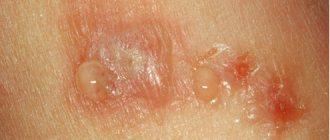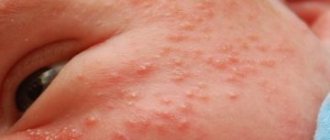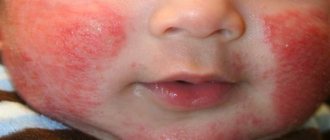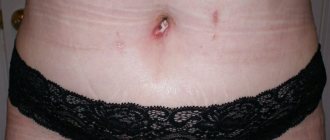Dermatitis in an adult
Scalp dermatitis affects about 5% of the population aged 18 to 50 and is a recurrent disease that is associated with impaired metabolism and sebum production of the scalp. It is observed in people with reduced immunity, suffering from chronic microbial infections or living in an unhealthy climate.
In adolescence, seborrheic dermatitis can develop due to an addiction to chocolate and sweets, eating fast food and a lack of vitamins and minerals.
Dermatitis in children
seborrheic dermatitis in a child
In a child, seborrheic crusts on the scalp are rare, but can still be observed from the first year of life. In children, dermatitis develops under the influence of hormones, as well as hereditary predisposition.
In children, from the first weeks of life, areas of peeling (gneisses) may appear on the scalp, and areas of maculopapular rashes on the body. This problem occurs in approximately 10% of newborns, with boys suffering from infantile dermatitis more often than girls.
Here you will find a similar article on the topic of skin dermatitis in children.
Types and clinical picture
Atopic
The symptoms of this dermatitis depend on the stage of development of the disease:
- Reaction to allergenic foods entering the body. Antibodies are formed and inflammation begins.
- Redness, swelling of the affected skin area. The appearance of a bright red rash, as well as small blistering rashes. Possible high body temperature. Atopic dermatitis can affect not only the scalp, but also other areas, such as the arms and elbows.
- If left untreated, the affected area begins to grow, affecting ever larger areas. If you scratch the diseased areas, the skin becomes wet, becomes crusty, and wounds form on it.
In the photo you can see the rash characteristic of the second stage of the disease.
Seborrheic
The clinical picture of seborrhea is as follows:
- itching occurs in the inflamed area;
- the skin becomes covered with scales, wet, sticky crusts;
- dandruff sticks to the hair.
Seborrhea can be of the following types:
Causes and symptoms of seborrheic dermatitis on the body
- Fat. This disease often affects teenagers who have just reached puberty. The epidermis intensively secretes sebum, becomes greasy, and the pores expand. Greasy hair sticks together and itching occurs.
- Dry form - localized on the head and other parts of the body. The skin becomes dry, cracks, and insufficient sebum is produced. This is reflected in the hair: it loses its strength and color and is easily damaged. The patient is accompanied by itching and dandruff.
- Mixed. On the patient's scalp there are both areas with excessive sebum production and insufficient secretion production.
- Eczematid is a mild skin lesion. The affected areas are small in size and there are few scales.
Causes of dermatitis
Dermatitis develops under the influence of many factors:
- Activity of fungal microflora.
- Endocrine system disorders, hormonal imbalance.
- Nervous disorders, chronic stress.
- Decreased immune defense of the body.
- Abrupt climate change.
- Excessive loads, overwork.
- Allergic reactions.
In addition to the scalp, the process may involve the eyebrows; in men, the cheeks and chin, neck and nasolabial fold.
Dermatitis on the head
Increasingly, people of different ages are faced with such an unpleasant disease as scalp dermatitis. It is a type of seborrheic dermatitis. The main symptom of this pathology is ordinary dandruff.
However, when it is detected, it is advisable to immediately select more suitable cosmetics so that the disease does not progress in the future. With an advanced form of dermatitis, a serious complication is possible - alopecia, as a result of which the patient partially or completely loses his hair.
To diagnose the disease, scrapings are taken from the patient's damaged areas of the scalp for microbiological analysis of the parasite. The patient also needs to undergo a comprehensive blood test, thanks to which the doctor will determine the presence of hormonal disorders and abnormalities in metabolic processes.
Causes of atopic dermatitis
Experts identify the following reasons for the development of dermatitis on the head:
- Hormonal disbalance;
- Following a strict diet;
- Presence of chronic diseases;
- Disturbances in the functioning of the gastrointestinal tract;
- Decreased immunity;
- Genetic predisposition;
- Incorrectly selected shampoo and hair conditioner;
- Increased sweating;
- Alcohol abuse;
- Critical vitamin deficiency;
- Increased fatigue;
- Diseases of the nervous system.
Symptoms of dermatitis on the head
Atopic dermatitis of the scalp manifests itself due to symptoms such as:
- Small white scales or red spots with bubbles;
- Dry scalp;
- Severe itching.
Treatment of the disease with medications
It is important to remember that you should not self-medicate. To find out how to get rid of dermatitis, you need to consult a doctor, get tested, and only after the diagnosis is confirmed, begin appropriate treatment.
First of all, the patient must review his diet and adhere to a diet. It is necessary to limit the consumption of foods that enhance the functioning of the sebaceous glands, namely: flour products, spicy, fried and fatty foods, as well as animal fats. It is worth excluding coffee and any alcohol from the menu. For a while, it is recommended to forget about honey, nuts, mushrooms, nuts, caviar and citrus fruits.
The patient should include in his menu foods that contain many vitamins and minerals (especially zinc). These include: cereals, fresh vegetables and fruits, seafood, etc. It is also useful to eat fermented milk products, eggs, meat and low-fat fish.
During an exacerbation of the disease, when dermatitis on the head is accompanied by a large amount of dandruff, a moderate microclimate should be maintained in the room. It is also prohibited to visit saunas and baths.
To treat dermatitis, you need to start taking proper care of your hair. The shampoo must match the patient’s hair type and have cleansing and degreasing properties.
If the patient has chronic recurrent dandruff, then stronger drugs cannot be avoided. These include: Ketoconazole, Zinc pyrithione, etc.
Sometimes they resort to using several antifungal agents to enhance the effectiveness of treatment.
It is useful to treat the scalp during the treatment period with Sulsena cream or Ketoconazole. Products containing zinc have a good effect. They have a drying effect and help normalize the activity of the sebaceous glands.
Some dermatologists prescribe brewer's yeast-based products to patients. They are very beneficial for the skin, as they restore its protective functions and improve its appearance.
Modern methods of treating dermatitis are UV irradiation and cryomassage.
Treatment of dermatitis with folk remedies
To quickly get rid of the disease, you can combine drug treatment for dermatitis on the head with the use of folk remedies.
If the patient has increased dryness of the scalp, then chop a couple of cloves of garlic and mix them with equal proportions of chopped fresh nettle leaves, mix thoroughly.
Then apply the resulting product to the scalp. It is advisable to cover your head with something after this. Keep the product for no more than 20 minutes.
After the time has passed, rinse your hair with water at room temperature, then rinse with prepared fresh chamomile infusion.
No less effective for treatment is a remedy based on honey in combination with castor oil. To prepare it, you need to mix 50 g of natural honey, castor oil, onion juice and add 1 egg yolk. Rub the resulting mixture into the scalp, then cover it and keep it with the product for 2 hours, after which you should thoroughly rinse your hair with warm water.
If a patient with dermatitis has oily skin, then you need to prepare a remedy using onion peels. This will require 50 g of husk and 2 glasses of water. Combine both ingredients, then place over low heat and simmer for 20 minutes. Then let the product cool, strain it and then lubricate your hair with it. Repeat the procedure every other day until signs of dermatitis completely disappear.
For severe itching and peeling, dermatitis can be treated with garlic and onions. To do this, you need to grind both components in equal proportions, mix and rub into the scalp, gently massaging.
Treatment of dermatitis with burdock oil is also useful. It should be applied to the affected areas and washed after 30 minutes. After the procedure, it is recommended to comb your hair well to get rid of softened scales.
Do not forget that while washing your hair, it is useful to use various decoctions of medicinal plants. The most effective are decoctions based on sage, nettle, chamomile, thyme and calendula.
A decoction of oak bark with the addition of honey is considered a good remedy for treating dermatitis on the head. This mask has an antiseptic effect and prevents the development of harmful microorganisms.
The appearance of dermatitis on the head in children
Children, like adults, are susceptible to this disease. It occurs in a child due to microbes and malfunctions of the sebaceous glands. In addition to the head, dermatitis can spread to the back, face and chest.
There are two forms of pathology:
- Mild, when the child only has dandruff;
- Severe, when large spots appear on the head, then peeling and crusting begin.
Treatment of dermatitis in children
The disease in a child should be treated with hypoallergenic shampoos. These include: Nizoral, Ionel, Skin-Cap and Sebulex.
With their help, the inflammatory process stops and the activity of the fungus is significantly reduced, as a result of which scales do not appear.
You can remove fatty yellow lesions from your child using an emollient baby cream. After this, you need to wash your hair with shampoo and remove the crusts. E
This is very painful for the baby, so first you need to moisten the scalp with Vaseline or burdock oil. Then use a comb with soft bristles, starting from the forehead to the back of the head. It is advisable to complete the procedure by applying a cream with a drying effect to the skin. It could be Friderm or Bioderma.
If a child is bothered by severe itching, then it is necessary to take Hydrocortisone or Clotrimazole, but only after consulting with your doctor first.
If a bacterial infection is detected, the specialist prescribes antibiotics (Penicillin or Oxacillin). In addition, intramuscular injections of glucose and ascorbic acid will be required. To treat the infectious course of the disease, one cannot do without opening the crust that has formed on the head using drainage.
Do not forget that treatment of dermatitis in children, as in adults, includes a hypoallergenic diet. Your diet should include foods that contain vitamins B, A and C.
When treating diseases in children, you can also resort to traditional medicine. A decoction of oak bark has proven itself well. You should take 50 g of dry raw materials and pour 250 g of boiling water.
Leave in a thermos for 4 hours, then add 1 tsp to the resulting product. honey and rub into the baby's scalp. After the procedure, the head should be washed with water at room temperature.
The manipulation must be performed every other day until all symptoms of dermatitis completely disappear.
Source: //dermatolog03.ru/dermatit/vidyderm/dermatit-na-golove.html
Types of dermatitis
There are two types of dermatitis on the scalp:
- seborrheic, developing under the influence of a fungus of the Malassezia furfur species;
- atopic, which occurs as an allergic response to food or household contact allergy.
Seborrheic dermatitis
Seborrheic dermatitis on the head occurs due to malfunction of the sebaceous glands under the influence of fungus, stress, infection or hormonal disorders.
The following symptoms are noticeable with seborrheic dermatitis:
- Erythemal or papular rashes form on the scalp.
- The skin is very flaky, the scales have a whitish or yellowish tint.
- Crusts form, the skin underneath becomes red and wet.
- Inflammation is accompanied by itching, burning, and pain.
- Below the hairline, the skin turns red and acne may appear.
- When scratched, the scabs are removed, revealing inflamed skin. This can lead to the development of weeping eczema.
When removing scabs with your hands, a secondary infection is introduced into the wounds, which aggravates the situation and leaves unsightly scars.
Atopic dermatitis
Dermatitis of an allergic nature most often develops in children of the first year of life or between the ages of 2 and 7 years. It manifests itself especially clearly in the first years of life, weakens with age, and, if left untreated, persists into adolescence. The disease affects adults in cases of advanced allergies and an unhealthy lifestyle.
Manifests itself in the form of the following symptoms:
- Severe itching.
- Bright red rash on the scalp.
- Small bubbles appear.
- With severe allergies, the temperature may rise.
The severity of symptoms is more pronounced the younger the patient. Additional symptoms of allergies may include digestive disorders, bronchial asthma, allergic rhinitis and dysbacteriosis.
Drug therapy
Different groups of drugs are used to treat dermatitis. They cannot be used without a doctor's prescription.
Antimycotics are required - Diflucan, Fluconazole, which destroy fungi. Antihistamines Cetrin, Zodak, Claritin eliminate itching.
If a secondary infection occurs, antibiotics cannot be avoided. Macropen and Erythromycin are usually used. They effectively fight bacteria.
On this topic
- Dermatitis
How to prevent the occurrence of toxic-allergic dermatitis
- Irina Nasredinovna Nachoeva
- September 24, 2020
Complexes containing zinc, tocopherol, ascorbic acid, vitamins A and B, and copper help strengthen the body.
Hormonal drugs Dexamethasone, Diprospan, Prednisolone are used for injections and are used in tablets.
Diseases of the digestive organs increase the activity of fungi on the scalp. In this case, Mezim or Enterosgel is additionally prescribed.
Excess sebum occurs due to endocrine disorders and failures. To normalize hormone levels, special means are used.
Severe stress contributes to the development of dermatitis. Nervous tension is eliminated using tinctures of valerian and peony, Glycine, Novopassit.
Treatment of seborrhea on the head is accelerated by procedures in the form of:
- darsonval;
- cryomassage;
- ultraviolet irradiation.
The treatment regimen for the disease includes a diet excluding fatty and fried foods, fast foods, smoked foods, citrus fruits, and sweets.
Diagnosis of dermatitis
The diagnosis is made by a dermatologist based on an examination:
- Clinical examination, history taking.
- General blood analysis.
- Analysis for hormonal balance.
- Dermatoscopy.
- Collection of material to determine the activity of fungi or pathogenic microflora.
- Determination of the state of the immune system.
Based on the test results, the doctor prescribes a set of measures to treat dermatitis. If atopic dermatitis is detected, additional allergy tests are performed to identify the causative agent of the allergy. An allergist treats dermatitis of an allergic nature.
Main types of skin lesions with contact dermatitis
With contact allergic dermatitis, the following types of skin lesions occur:
- Scuffs and calluses - occur as a result of wearing tight or uncomfortable shoes, clothes with rough seams.
- Diaper rash – causes skin areas to rub against each other. Complications of an infectious nature often occur. The ingress of microbes leads to the appearance of ulcers. Yeasts contribute to the appearance of diaper rash.
- Bright red spots with flaking scales - Leiner's dermatitis, develops from diaper rash. Happens in infants due to improper skin care. Often a consequence of an infectious disease.
Treatment of dermatitis
To get rid of dermatitis, you will need complex therapy using special shampoos, ointments and cosmetics. In some cases, they resort to physiotherapy and also prescribe an individually selected diet.
Here you will find an article about another type of dermatitis - the treatment of perioral dermatitis.
Shampoos against dermatitis
Shampoos for patients are selected specifically; they contain the following components:
- Tar.
- Ciclopirox.
- Zinc.
- Ketonazole.
You might be interested! How to treat allergic dermatitis in adults?
Specialized shampoo is purchased at the pharmacy. It is better to wash your hair with boiled water or herbal infusion: calendula or chamomile. It is necessary to carry out hygienic care of the scalp every day until the symptoms completely disappear.
Ointments
In the treatment of atopic dermatitis, ointments based on glucocorticoids are often used:
- hydrocortisone;
- betamethasone;
- clobetasol.
Seborrheic dermatitis is treated with ointments that suppress fungal activity based on selenium, salicylic acid, tar and ichthyol. Apply the ointment to the scalp in an even, thin layer at the roots of the hair, slightly extending beyond the hair growth line.
After the symptoms subside, the goal of therapy will be to soften the skin and restore metabolism; during this period, ointments based on plant extracts, ichthyol and hyaluronic acid are used.
For any type of dermatitis, you can use Losterin , which contains specially selected components and will help eliminate the symptoms of the disease in a short time.
Diet for dermatitis
For dermatitis, the main goal of the diet is to establish the balance of substances in the body, then the symptoms of the disease will subside. Diet can also help avoid relapse of the disease.
The following products will be prohibited:
- Strawberries, the citrus family and any highly allergenic fruits.
- Fast food products, baked goods, chocolate and confectionery.
- Smoked, spicy foods, foods with excess salt, marinades and canned food.
- Foods with excess fat.
- Mushroom dishes.
- Caviar of all types of fish.
It is recommended to base your diet on the following products:
- Vegetables: pumpkin, zucchini. Other vegetables can be consumed in limited quantities.
- Dietary meat: turkey, rabbit, beef, chicken.
- Berries, both fresh and frozen, juices and fruit drinks.
- Porridge.
- Fermented milk products: kefir. Low-fat cottage cheese, yoghurts.
It is recommended to drink more fluids, freshly squeezed juices, fruit drinks and herbal tea during the course of treatment. You need to eat regularly and develop a balanced diet. To strengthen the microflora, it is necessary to consume more fermented milk products and, if necessary, take a course of prebiotics.
In case of atopic dermatitis, you must monitor your diet with particular rigor, avoid allergenic foods, and, if necessary, take a course of antihistamines.
Folk remedies
To normalize the functioning of the sebaceous glands, traditional medicine recommends using the following means:
- Sea salt - a solution is prepared from it for rinsing hair after washing.
- An infusion of sage or string is used to make lotions - this procedure relieves burning and itching. It is especially useful for children to rinse their hair with a solution of the series - then they scratch their hair less and do not get infected.
- To get rid of crusts, you need to prepare an infusion of burdock root, elecampane and St. John's wort: the collection is simmered over low heat for about 20 minutes, then infused and filtered. The resulting product is rubbed into the roots of the hair after each shampoo, after which a warm cap is put on for forty minutes. There is no need to rinse off the product.
- To soften the crusts, you can prepare an ointment based on a decoction of plantain, St. John's wort or calendula: the decoction is evaporated by half of the original volume, then added to Vaseline. You can replace Vaseline with butter without salt. The resulting ointment is rubbed into the scalp until the symptoms disappear completely.
- It is recommended to make lotions from oak bark, chamomile or sage infusion.
- Instead of shampoo, you can wash your hair twice a month with mustard powder
- To suppress fungi , you can use a weak solution of vinegar or salicylic acid when washing your hair instead of water.
When using any products, the skin must then be washed thoroughly with water; it is better to avoid using ordinary soap, replacing it with tar soap.
Medicinal shampoos
To restore the scalp and improve the condition of the hair follicles, it is not enough just to use ointments and creams that destroy fungi. Special shampoos speed up the treatment period for dermatitis, since they also have a negative effect on pathogens.
Ketanazole, which serves as the active component of Nizoral, prevents the proliferation of harmful microorganisms. The product normalizes the amount of sebum and copes with inflammation.
Thanks to the use of sulsen shampoo:
- Improves the appearance of hair.
- Bacteria die.
- Itching is reduced.
On this topic
- Dermatitis
Effective methods for treating perioral dermatitis on the face
- Inna Viktorovna Zhikhoreva
- September 25, 2020
Helps cure oily seborrhea, get rid of scales and dandruff Friederm Tar.
Keto Plus shampoo, which contains zinc, ketanazole, and coconut oil, restores the skin, relieves itching, and prevents fungi from multiplying.
The inexpensive product Mycozoral effectively fights pathogenic microflora; after washing with this shampoo, swelling goes away, dandruff disappears, wounds heal, and hair stops falling out.
Prevention of dermatitis
In order to prevent the occurrence of dermatitis, the following measures must be observed:
- Lead a healthy lifestyle: spend more time outdoors, give up bad habits
- Eat nutritious, healthy foods, do not overuse fats, carbohydrates, salt and spices
- Strengthen the immune system: hardening, taking vitamins, controlling intestinal microflora are indicated
- Organize your daily routine, get a good night's sleep
- Avoid stress and overwork
- Maintain personal hygiene, wash your hair regularly, use strictly individual hygiene items: washcloth, soap, towel
- Replace bed linen at least twice a month, in case of exacerbation of the disease - weekly
- When choosing cosmetics and shampoos, consult a dermatologist and cosmetologist.
In order for the immune system to be able to resist a fungal infection, it is necessary to receive full treatment for any infectious disease, preventing it from becoming chronic.
Treatment with folk remedies
Traditional medicine recipes are used to eliminate negative symptoms and weaken them. Among the most popular non-traditional methods for the treatment of atopic dermatitis on the head are:
- alcohol tincture of St. John's wort - suitable for topical application to affected areas. Use after using anti-dermatitis shampoos;
- onion-garlic mask. To prepare it you just need to chop the onion and garlic. Mix both components and apply to your head. It is better to wrap the mask with film and a towel. After 2 hours, wash off the composition from your hair;
- decoction of 2 tbsp. l. oak bark and 2 liters of water. You need to rinse your hair with this mixture.
It is impossible to get rid of the disease using folk remedies alone. They, just like medications, are selected taking into account all individual characteristics.
Atopic dermatitis can affect any part of the body. People of all ages suffer from the disease. It appears due to many reasons.
Without timely treatment, the disease will actively progress and be complicated by various pathological conditions. The problem cannot be neglected - at the first sign of it, it is better to consult a doctor for diagnosis and prescribing adequate therapy.
